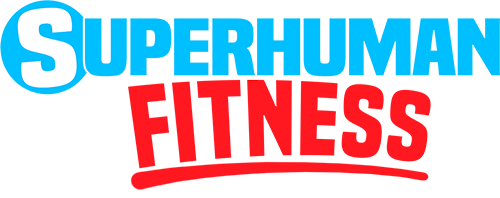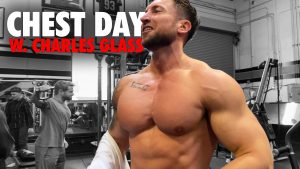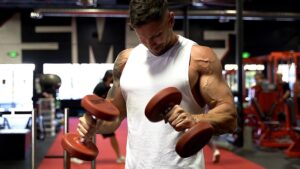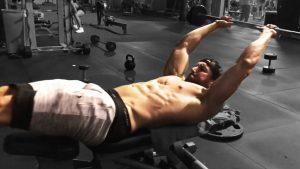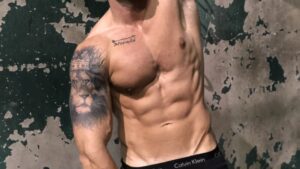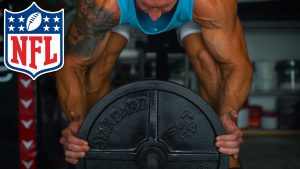Today I want to show you the perfect science backed full body workout for growth in every muscle in your body!
I'm talking full body muscle gains from head to toe - because we are going to incorporate every type of compound movement that will hit all of the largest muscles in your body - chest, back, quads, hamstrings, abs, biceps, triceps, shoulders, lats, forearms, and even traps!
There are a lot of full body workouts that claim to be "the best" but in order to maximize growth everywhere you need to have a movement where you are hinging, pushing, pulling, lunging, squatting, and carrying.
This is the perfect full body workout for mass because it will only take you about 45 minutes to complete, and it will maximize the 3 scientific ways that your body builds muscle mass with the Balloon Method!
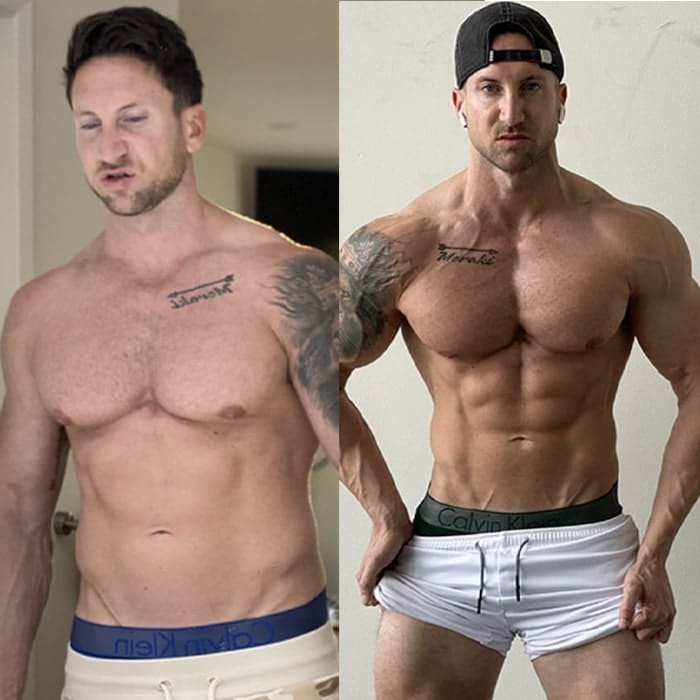
The Balloon Method workouts get me absolutely shredded in 8-12 weeks because they are based on SCIENCE. Maximizing the ONLY 3 science backed ways your body can build muscle in as short of time as possible in each workout.
Try this full body workout for mass up to 3x per week as a complete muscle building program! I also recommend that you perform a “finishing set” of each exercise where you drop the weight to about 50% of your 1 rep max and go for 15-20 reps until failure.
I recommend on the heavy sets that you lift about 85-90% of your 1 rep max. If you need help figuring out what that number should be for you based on your current strength, head over to our Superhuman One Rep Max Calculator to figure out the best weight for each of these moves!
| #1 Barbell Overhead Press | |
|---|---|
| Sets | 3 + finisher set |
| Reps | 6-10 |
| Rest Time | 90 seconds |
The barbell overhead press (or "military press") is a powerhouse of an exercise that works the muscles of the shoulders and upper back.
When executed with precision and technique, it can not only define your shoulders but also shape your upper back to give you a broad, balanced physique. This total-body lift effectively develops the shoulders and upper back, two of the most vital areas of the body for strength and muscle tone.
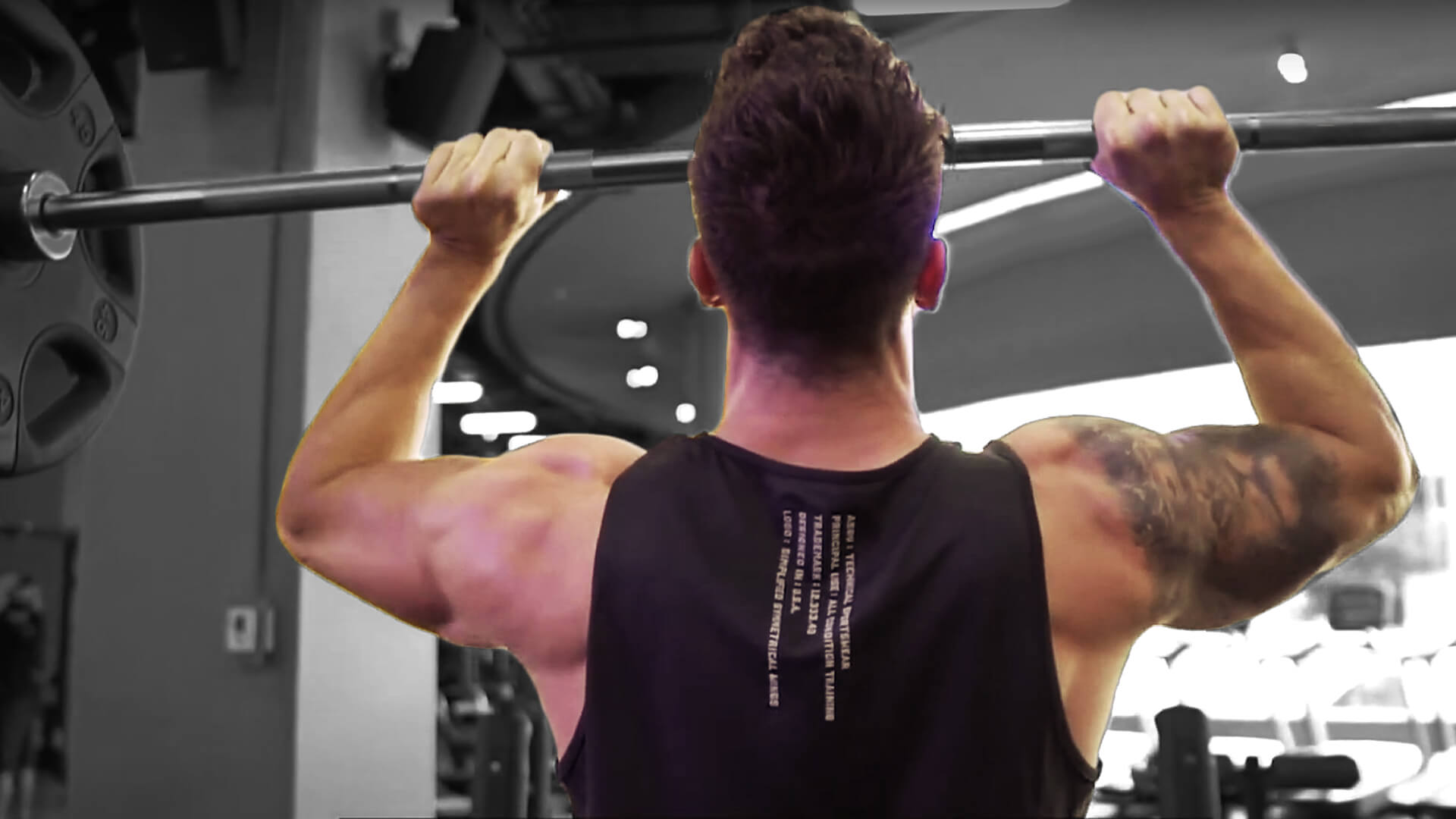
Overhead pressing strengthens the entire body. The press isn't just for the shoulders and arms—the standing overhead press is also a great way to work the abdominals and hips, as well as helping to improve your leg strength.
The overhead press may be the most effective exercise for developing bigger shoulders, upper back, and triceps. It's a favorite of fitness enthusiasts because it's an incredibly effective way to develop these muscle groups. The weight you use for the press must be heavy enough that your muscles won't tire out and at the same time light enough that you can complete 8-12 reps in an extended set.
Before You Perform The Overhead Press: Safety First!
You'll want to stay away from the overhead press if you're new to strength training because of its heavy loading and nervous system demands. While it's one of the most impressive lifts and it's fantastic for building your upper body, you need a solid and established fitness baseline and a grounded education in strength training before making a foray into the military press. The truth is, some folks' bodies just can't handle training with heavy weights overhead without injury.
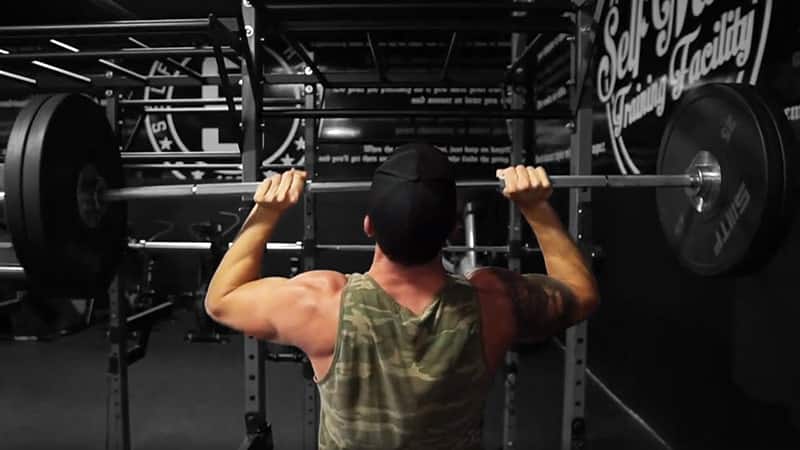
The barbell overhead push press and other overhead press variations can be dangerous when performed by weightlifting amateurs. If you don't have the proper upper body strength to manage the weight, you can cause serious injury on your very first rep. Even strong lifters must take great care to perform the overhead press with the appropriate technique to ensure that they don't cause muscle strain on their neck, shoulder blades, arms, pectorals, or core muscles.
Most people can't afford a personal trainer, but there are some exercises you can do to check your core, arm, and shoulder strength to find out if you're ready to start adding the overhead press to your lifting regime.
Shoulder Blade Touches
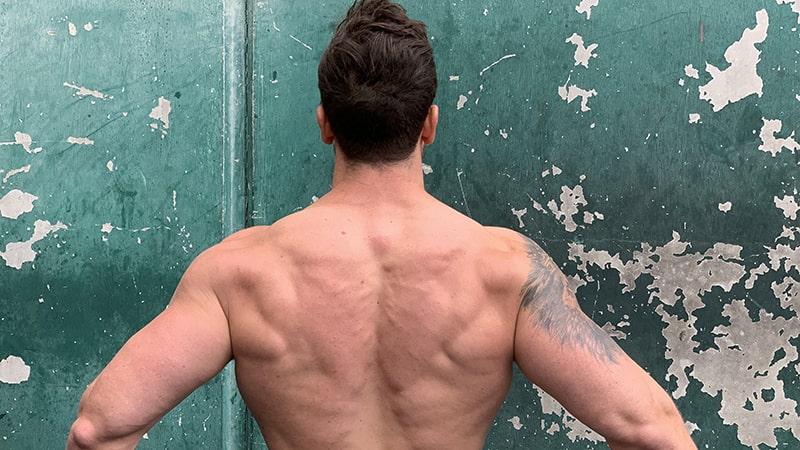
Stand straight with your arms at your sides and feet at shoulder-width apart. Reach both arms behind you and touch the tops of your shoulder blades. If you can do this without touching anything other than your arms, then you have the flexibility to perform the overhead press.
If you can't, you can still perform this exercise with dumbbells or kettlebells, but don't pick up the bar quite yet.
Overhead Reach
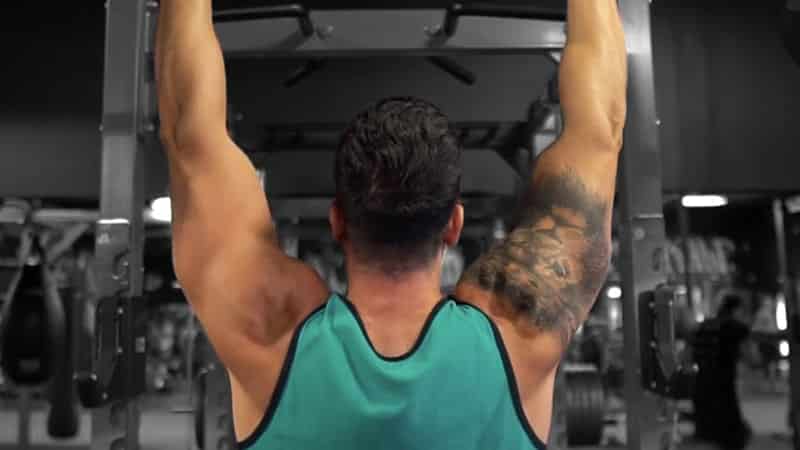
Stand in front of a mirror, arms at your sides. Raise both arms overhead. If you can, raise both arms parallel with your ears—without your ribs moving, and without anything else moving.
To pass this test, you need to be comfortable while standing straight with your arms upright and make sure your ribs are still.
If you've failed, don't overanalyze why. Just attack your next workout with more power and precision. Don't hit the bar just yet, but you can start trying a light overhead dumbbell press (or kettlebells).
When To Use The Overhead Press
A multijoint movement should always be done first in your workout. While you don't necessarily need to perform overhead pressing first in a workout, it's best to do this heavier exercise as your main lift especially if you're just starting out.
Depending on the lift variation, place it as an accessory movement or a support exercise for your primary lifts. This heavy exercise is taxing on your CNS because of its full-body nature and relatively heavy loading.
Planning Your Overhead Press
Form is essential when it comes to complex movements, especially when lifting weight that's too heavy. When form breaks down during a training session, injuries increase the likelihood of poor results. As a result, athletes are better off choosing sets and reps schemes that allow for form and posture maintenance.
The ideal rep range for overhead pressing is 3-8. Any more or any fewer reps and you risk breaking form, muscle strain, and fatigue. This has been proven time and time again in studies on overhead press form with novice to advanced lifters. On the other hand, 3-8 rep ranges are also known for increasing strength gains over longer durations of training.
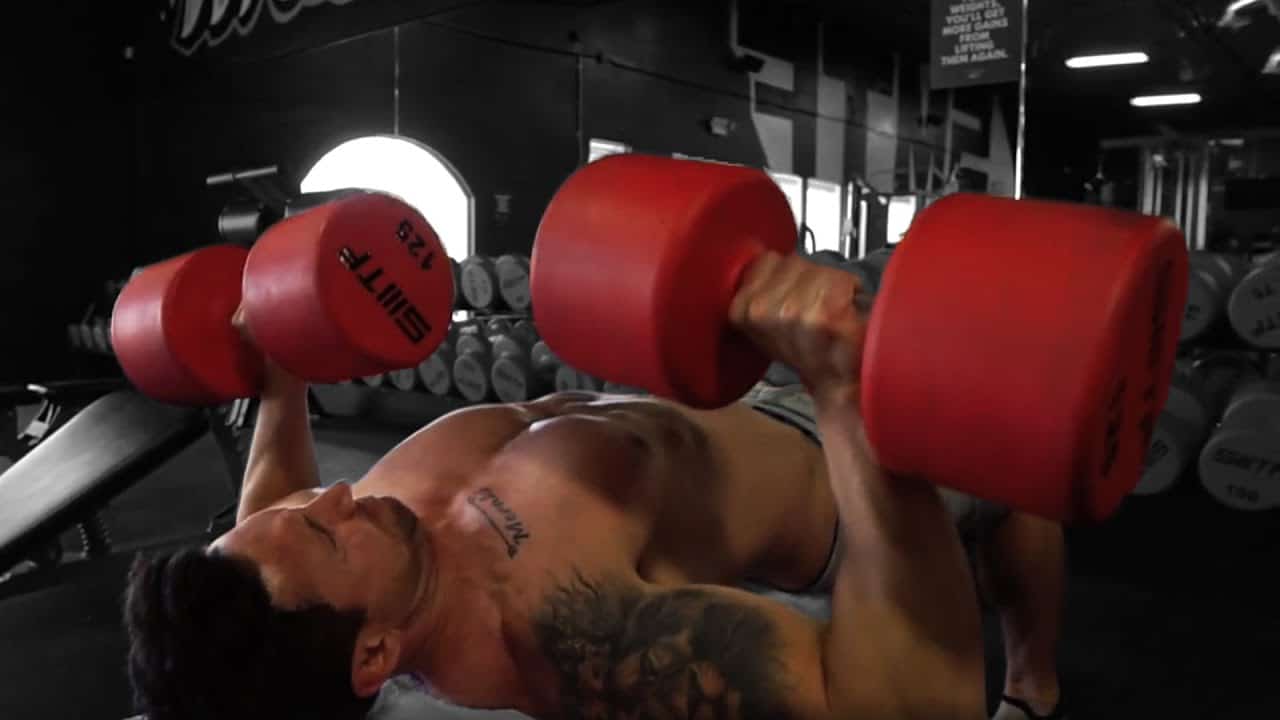
Sometimes increasing the number of reps can lead to plateaus rather than progress. If you're going over your 8-rep goal, try adding more weight or reducing rest time. As with any workout, training balance is typically the answer more than going to extremes.
For many new lifters, dumbbell and kettlebell variations are their main lift. The overhead press is just one example of the many lifts that can be done with a lighter load and easier form.
Perform dumbbell or kettlebell overhead press sets in the 5-12 rep range with lighter loads, and you'll give your body the time it needs to grow. The 5-12 rep range is ideal for these exercises since it builds strength without setting you back in terms of your range of motion or exertion.
How To Perform The Overhead Press
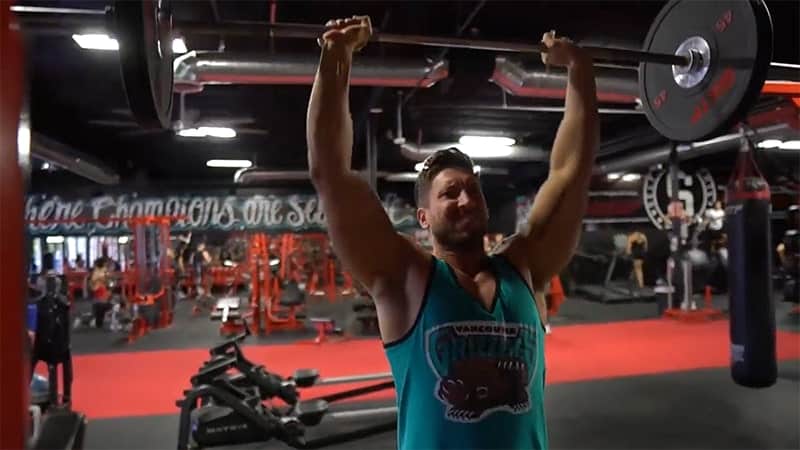
To perform an overhead press with proper form, stand with the bar on your front shoulders. Position the bar on your shoulders, and grab it with an overhand grip, just outside shoulder-width apart. Straighten your arms until you are in a rigid pressing position, elbows locked at the top, keeping a straight bar path. At the top, hold the bar for a second before lowering it back to your front shoulders.
The overhead press with dumbbells and kettlebells is similar in execution but with one slight difference. The hands start out in a neutral position at the bottom, like a dumbbell press. Rotating the arms parallel to the ears as you press makes use of the shoulders' entire range of motion. The rest is the same. As the weight is moved up and back, the elbows extend as they are pressed up and back.
Overhead Press Form And Stance
When doing the overhead press, your heels should be under your hips. This means that you should have a narrow stance. But your heels shouldn’t be touching. Stand similarly to how you stand when you perform the deadlift.
Lower Body
Staggering your feet might improve your overhead press, but it can also hurt your lower back and hips. Overhead press with your feet parallel and shoulder-width apart to evenly distribute the pressure on your back and hips.
You can turn your feet out slightly, but make sure that they are aligned horizontally when you look down. Don’t stagger your stance by putting one foot forward.
Your feet should be flat on the floor when you overhead press. This increases body balance and allows you to use more of your body weight to lift the bar. To optimize your bar control, keep your forefeet, heels, and toes firmly on the floor.
Avoid lifting your toes or raising your heels. Use only the muscles in your feet and legs to overhead press, not momentum from your upper body.
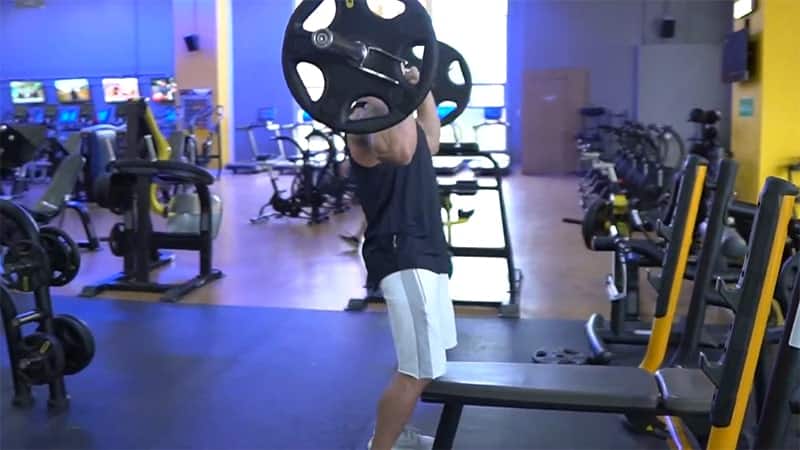
Keep your legs straight and squeeze your glutes. Your shoulders are doing the work, not your knees. Hyper-extending your knees is cheating — you’re taking the work away from your shoulders.
Squeeze your quads and keep your legs straight. If your knees hurt, you’re probably hyper-extending. If you still can’t lock your knees, decrease the weight by 10%.
A push press is not the same as an overhead press. The push press uses your stronger hip muscles to drive the bar off your shoulders. It allows you to press heavier weights, but it doesn’t work your shoulders like an overhead press does.
If you bend your hips while doing an overhead press, you will cheat yourself out of better results. You should never cheat during a workout. Think about squeezing your glutes to keep your hips straight.
Grip
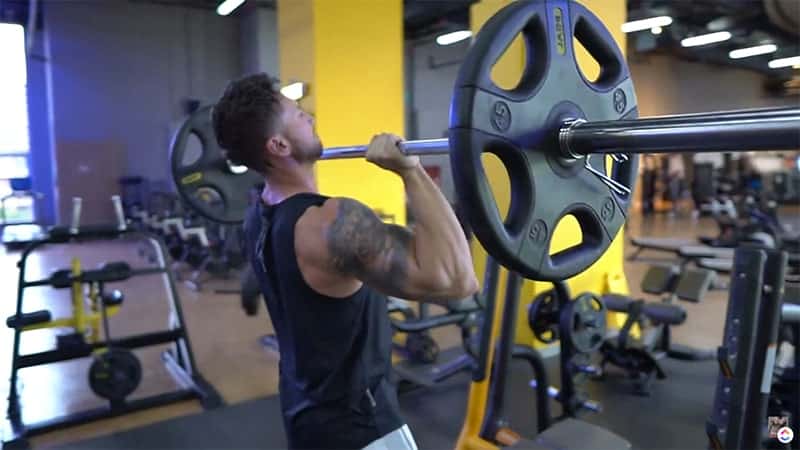
Your grip is very important for the overhead press. If you want to do this exercise safely, you must wrap your thumbs around the bar.
This way, the bar cannot slip out of your hands and hit you in the head. It also makes you stronger because you get to squeeze the bar harder.
This helps engage your arms, shoulders, and chest muscles more — making them stronger too. Plus, a full grip allows you to overhead press more weight without causing bad form.
Should You Stand Or Should You Sit?
What's the difference between doing this movement standing vs. sitting? When you do barbell movements with weights, your body must use stabilizer muscles in each shoulder joint to keep each body part pressed against the weight at all times, or you'll experience a painful injury. Strong, stable shoulders help prevent you from bending over during lifts.
Standing Overhead Press
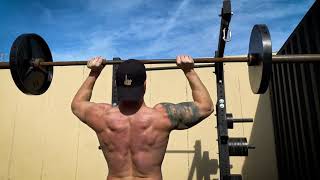
The standing barbell press takes more total-body strength because it builds more core stability, trunk stability, and tension. It also builds more shoulder strength. However, if you're already in fantastic shape and strong, the seated overhead press will build a higher percentage of your overall upper-body strength, but not necessarily more overall strength.
Standing overhead presses require more core stability and total-weight tension than the seated variety because your hips and legs need to be engaged to prevent you from bending over.
Seated Overhead Press
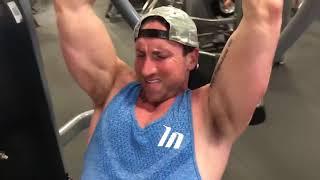
Seated overhead presses are best for those with stronger core strength and less flexible joints. They're typically easier to perform since you stabilize your body with the bench.
This makes them a good choice for lifters who are newer to weightlifting exercise and those who aren't in the best of physical shape. They're also the best alternative for lifters with lower-body disabilities who want to utilize the ultimate upper-body lift.
Muscle Groups Worked By The Barbell Overhead Press
The overhead press utilizes a variety of muscles to lift the weight. Your shoulders and arms are the prime movers that press the bar overhead. But everything between your shoulders and the floor should stay tight to balance you as well as keep you from dropping the weight on your neck or elbows. The overhead press concentrates several muscle groups all at once to build strength and power.
Arms
Straightening your elbows works the muscles on the backs of your arms, your triceps. Their size makes them stronger than any bicep. Your forearm muscles also jump into action to hold the weight.
Back & Shoulders
To overhead press, lift the bar with straight arms so that your feet don't leave the floor. This targets the muscles in your shoulder: your front, side, and back deltoids. Muscles are developed evenly with heavy weights so that you build wider shoulders.
Core
Your core muscles are the foundation of a strong body. They stabilize your torso while you press the bar overhead. Stronger abs are leaner abs, especially when paired with a balanced diet.
Legs
Your legs balance your body while your arms and shoulder press the bar. This works your hips, thighs, calves, and ankles. The overhead press doesn't work these muscles quite like squats because your legs don’t move during your reps. Instead, they stay straight. They have to support the heavyweight of the bar. If you want to work your lower body, squats are a better choice.
Important Safety Considerations For The Overhead Press
Any exercise can cause unnecessary strain or injury when done incorrectly, but the overhead press is a full-body workout using a heavy free weight overhead. This makes it one of the more hazardous lifts you can perform, and a number of things can go wrong if you're not adequately prepared or if you don't have enough strength to perform the overhead press correctly.
Before adding the overhead push press to your workout routine, perform the safety checks listed above and consider these safety risks associated with the lift.
Watch Your Shoulders
The overhead press has been proven beneficial for shoulder health, but you need a good form. It strengthens your shoulders and rotator cuff muscles. These muscles secure your shoulder joints and prevent dislocations. Good form also prevents muscle imbalances in the bench press by strengthening your rear shoulder muscles. However, poor form will hurt your shoulders. The bench press is a great exercise to do for strong shoulders that will then help with your overhead press form.
Do shoulder shrugs. Start by holding the bar up high with your elbows 45° in. Don’t use a grip wider than this or your elbows will flare like you do on the bench press. Press the bar in a vertical line until your arms are straight at the top. To finish the rep, lift and tilt your shoulders. The barbell should stay on a straight bar path directly over your shoulder joint while you do this.
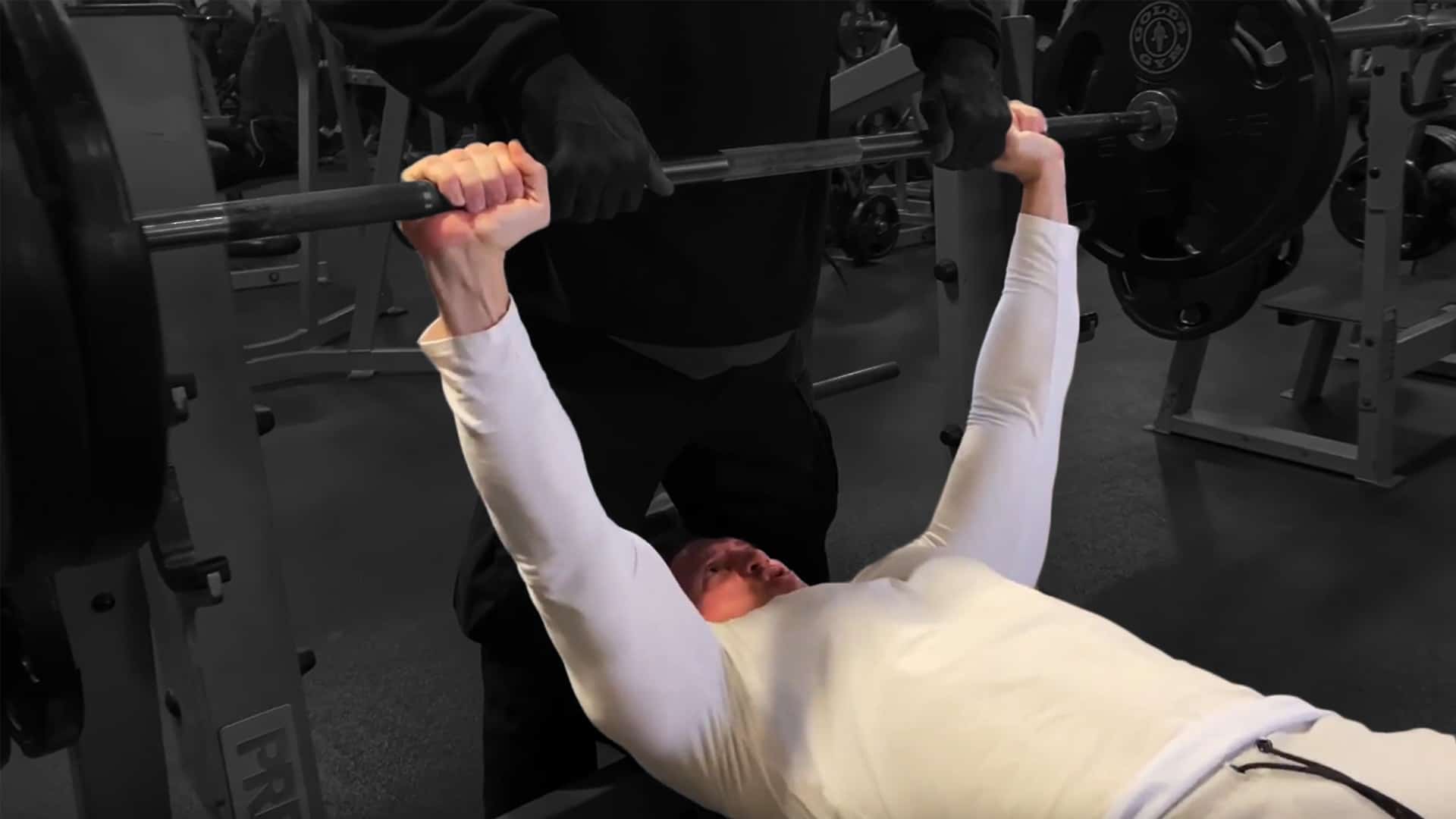
Shrugging is a key to strong shoulders. This will activate the trapezius muscle, rotating the shoulder blade out and lifting the bony process of the upper arm bone (humerus). This creates space between the top of your humerus and your acromion, which can alleviate shoulder pain and decrease inflammation.
If you don’t shrug at the top of your bench press, you are putting yourself at risk for injury.
Be Ready To Drop The Bar
People are scared of overhead pressing when they’ve never done it before. They think that the barbell will fall on their head and crush them before they even get a chance to finish the lift. However, this is a myth. A weight that is too heavy for you to control won’t go as high as your head. You'll fail at the bottom because it's too hard.
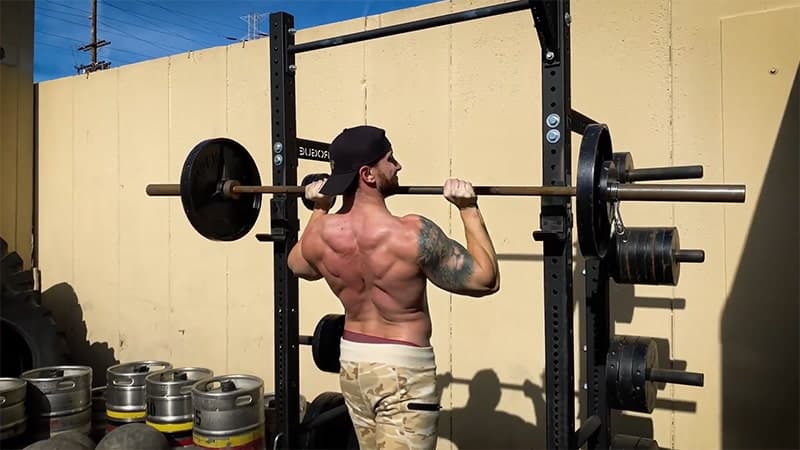
When doing the overhead weight press, there are only two ways you can drop the bar on yourself. The first is to use a thumbless grip. If this happens, the bar will fall out of your hands and hurt you. It’s better to have a full grip with your thumbs wrapped around the bar.
Another way to drop the bar is to not lock your elbows at the top of the move. The weight will collapse over your head if you fail to lock your elbows. Always lock your elbows at the top of the overhead press.
You don’t actually need to overhead press inside the Power Rack with safety pins set. You can simply go right into your shoulder press when you fail a rep. If you prefer to overhead press inside the Power Rack with safety pins set, arm yourself with confidence and do it.
Benefits Of The Barbell Overhead Press
You don’t need to isolate your shoulder muscles with lots of different exercises. The overhead press gets the job done. It works your entire shoulder girdle evenly, allowing you to lift heavier weights.
The overhead press strengthens your rotator cuff muscles. It's a safer and more effective way to prevent and fix shoulder injuries than internal and external rotation exercises with dumbbells. Plus, unlike the bench press, it strengthens the back of your shoulders, not just your chest.
| #2 Wide Grip Pull Ups | |
|---|---|
| Sets | 3 + finisher set |
| Reps | 6-10 (if you can do more than 10, do weighted!) |
| Rest Time | 90 seconds |
This exercise is a definite must in any upper body workout program. It’s compound, it’s challenging, and it’s something that is easily scalable to your own strength level. If you aren’t able to do 8-10 bodyweight pull-ups, start focusing on just lifting your own weight.
If you can lift your own body no problem, then it’s time to start adding more weight.
The pull-up is going to target the lats, biceps, and back, promoting great strength and size gains. If you want to work your biceps to a larger degree, the best way to do that is with a wide grip, parallel grip hand position.
On this exercise, we’ll add one more unique twist at the end to further challenge your body and maximize you’re results – the static hold. On the very last rep you do, you’ll hold that lifted position for at least a few seconds and then very slowly, lower yourself down in a controlled manner. The idea here is to keep constant tension on the muscles and really bring them to that point of higher fatigue.
To keep progression coming, use the same rep and weight scheme as what was noted above for the first exercise.
| #3 Barbell Deadlift | |
|---|---|
| Sets | 3 + finisher set |
| Reps | 6-10 |
| Rest Time | 2 minutes |
The barbell deadlift was bred out of necessity. It was built specifically for the military and its purpose was to teach soldiers how to use their strength properly. No matter your body type, you can learn to barbell deadlift properly.
We're going to cover everything you need to know to perform the barbell deadlift properly so you can add this critical exercise to your gym workout routine immediately.
How To Perform The Barbell Deadlift
The barbell deadlift is a challenging movement because you start each rep at the bottom position. This means that your back, legs, and arms must be strong enough to deadlift the weight from the floor.
In a barbell deadlift, the “dead” refers to dead weight. That means you must use proper form to allow your barbell to start from a dead stop on the floor every time, rather than just moving up top.
Setup And Placement
A barbell deadlift should be set up with heels placed hip-width apart and your feet parallel, shoulder-width apart. This is because the distance between your heels should be hip-width apart. So if your hips are wider, you should stand with your heels placed further away, and vice versa.
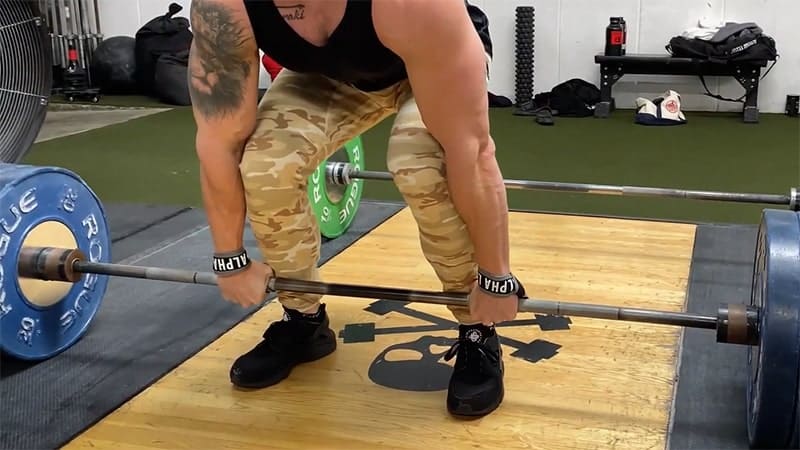
The barbell should always start over your mid-foot because when the weight leaves the ground, it will pull you forward.
The barbell should never start over your toes because when the weight leaves the ground, it will pull you forward. This puts the bar away from your center of gravity and further from your balance point. This will make you lose balance, feel harder on your lower back, and put more pressure on your shins.
Deadlifting with your squat stance is dangerous. You need to create space for your arms when you set up. If your legs are too far forward, they will block your arms from moving freely. This will make you pull with bent arms which puts a lot of pressure on your biceps and elbows.
An optimal hip position for your barbell deadlift depends on your build. If you have long thighs, your hips will be higher than if you have short thighs. Regardless of build, proper deadlift positioning involves having a more vertical torso with the hips and knees in the highest possible position, feet hip-width/shoulder-width apart. If you set up properly and are meticulous about your form, you can barbell deadlift safely and productively whether you have long or short thighs.
When you do deadlifts, bend your knees out at shoulder-width so that they point out at about 15 degrees, over the top of your toes. Do this while you set up and while you pull the weight up. This will help your range of motion through your hips, upper back, and posterior chain.
Grab The Bar
When you barbell deadlift with a poor overhand grip, pain will develop in your hands. An improper overhand grip causes the bar to slide down your palms and place pressure on skin folds. This hurts and leads to calluses that tear easily.
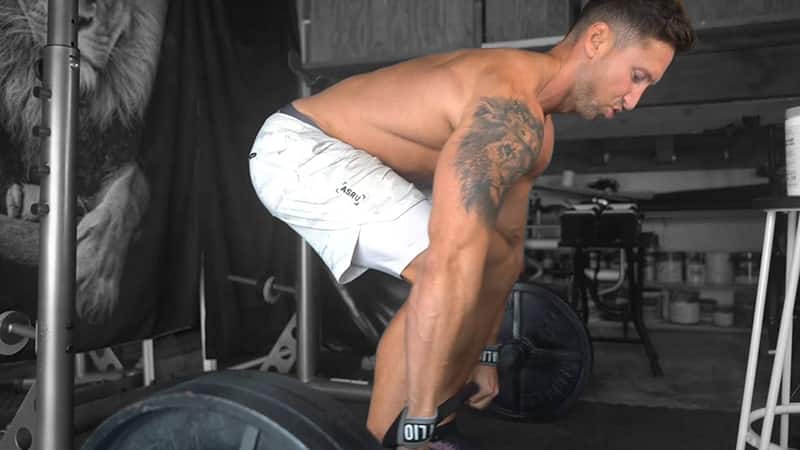
To perform the exercise correctly, grab the bar narrow. Narrowing your overhand grip will make your hands vertical when you look at them from the front. This will help decrease the distance your arms must move in order to lift up the weight, and you can deadlift more weight with a narrow grip.
Grab the bar with your palms toward you. This is the standard or double overhand grip. You can use the mixed grip, but it’s not an everyday thing. Save it for when your grip strength fails and sticks after too much deadlifting. Start with a normal grip on most sets, though.
Lift The Bar
The barbell must start below your midfoot and move up in line with your shins because those are the supporting muscles.
Start with your shins against the bar. If you place them correctly, it will be easier to lift the bar over your knees and thighs. Don’t let it drift away from your body or it will cause pain in your lower back. To protect your legs, wear pants or socks that are long enough to cover your shins.
Lift the bar in a vertical line. This is the most effective way to pull because it is the quickest path from ground to lock-out. The shortest route is a vertical bar movement. It should not slant forward because that makes the bar travel path longer and throws off your balance.
Take a big breath, and then deadlift the weight off the floor.
Slowly pull up on the weight. Don’t push with your arms, and don’t try to deadlift the weight without straightening your elbows. Pause first, and then pull the weight into your shoulders, breathing deeply. Don’t rush and keep your movement even.
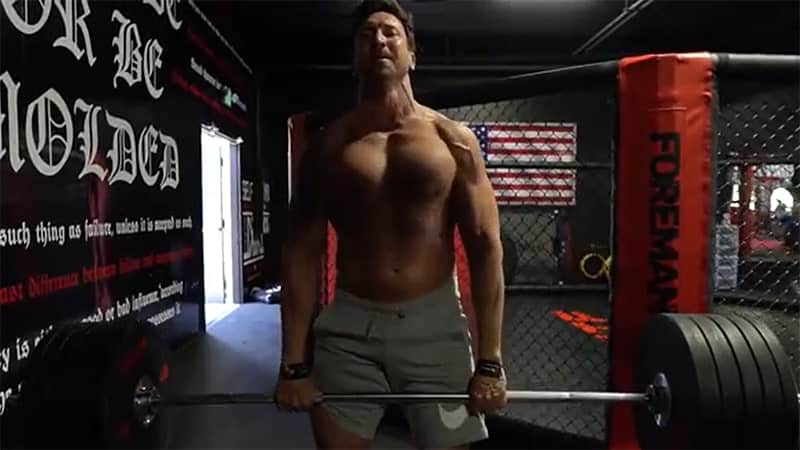
If you find that the bar is moving too far away from your midfoot during a power clean, try resetting. Stand up, get the bar still, and get your midfoot back under the bar. Then get in the proper position and pull. Don’t attempt to pull the weight over your foot, because you might not be able to get in a proper position.
Locking your knees at the top of every rep is an important part of performing conventional deadlifts correctly. This strong, locked position is key to success because it gives you a stable frame to hold the weight. Don’t cheat yourself by not locking your knees at the top of each rep.
If the bar will not budge, your grip strength might be insufficient. Place chalk on your hands and try again, this time with a mixed grip. It will provide you with a better grip, and you should be able to lift the weight. Make sure you don’t give up too early; if the bar still will not move, it’s too heavy for you.
Lower The Bar To Finish Your Deadlift
Going down should follow the path of going up. To lower the bar, you should move down in a straight vertical line as this is the shortest distance to the floor. It should pass just above your knees to decrease stress on your lower back.
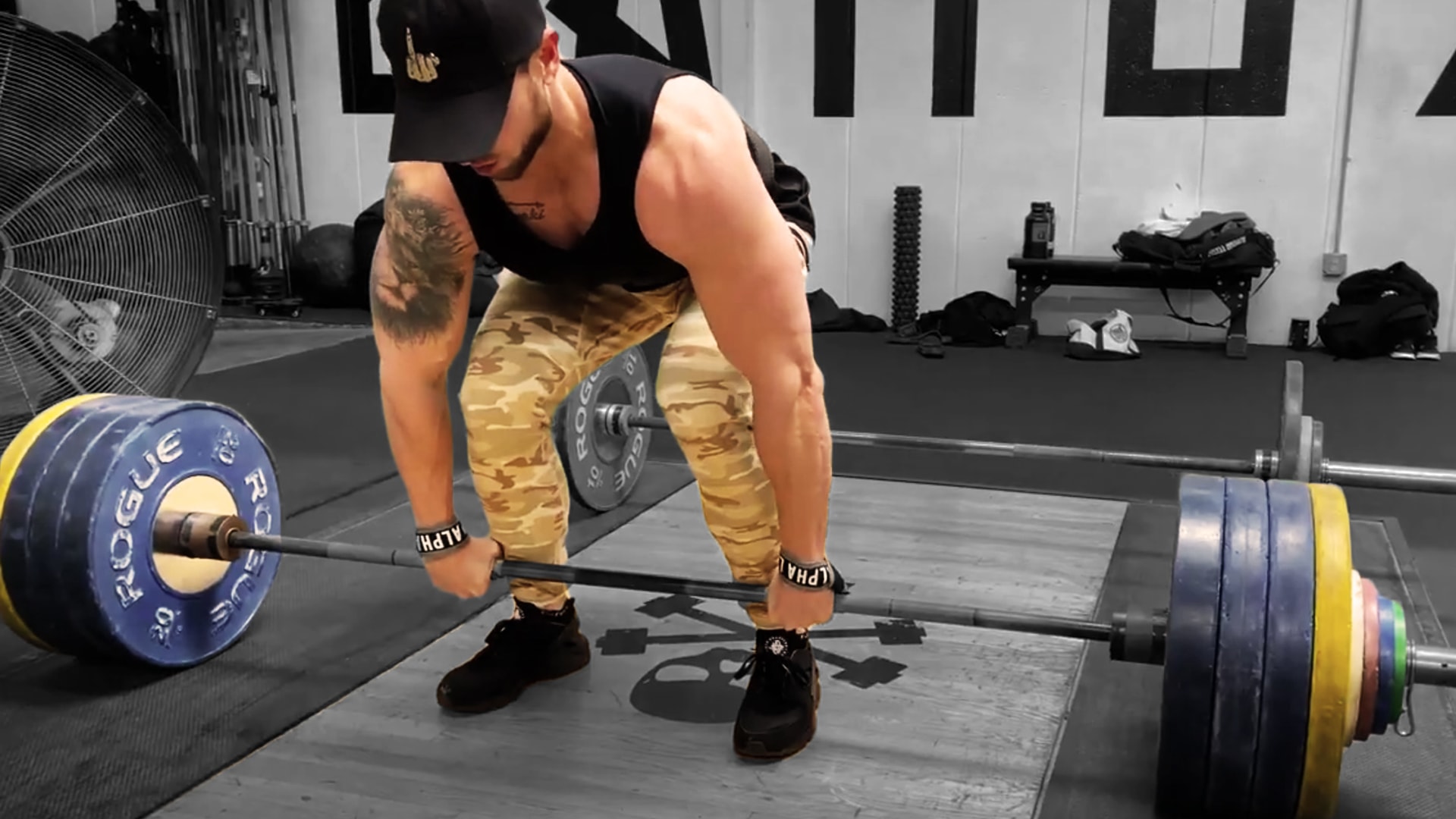
Lower the bar keeping it in contact with your legs to decrease the downward pressure from your body weight on your lower back. Your spine must stay aligned in its neutral position.
Then lower the weight by moving your hips and knees back. Keep your legs almost straight while moving mostly from your hips. The goal is to keep your knees back and out of the way of the barbell, so you can lower it in a vertical line to your midfoot. If you bend your knees, you'll struggle. They’ll come too far forward and block the barbell from reaching the ground.
Benefits Of Adding Barbell Deadlifts To Your Workout
The deadlift is a great strategy to build big muscles and increase stability. A recent study from Texas Tech found that after ten weeks of doing the deadlift, participants gained significant amounts of both muscular strength and muscular stability, especially women who had little experience with the deadlift or weightlifting.
Improved Full-Body Strength
As you build muscle in your abdominal area, your back and posterior chain become stronger. That means it’s less likely to hurt. That also allows you to work out longer and deadlift more weight. Strong muscles make an indelible impact on your performance at the gym and when lifting weights. In addition, this full-body move can save time because it works many muscles at once in a super short amount of time.
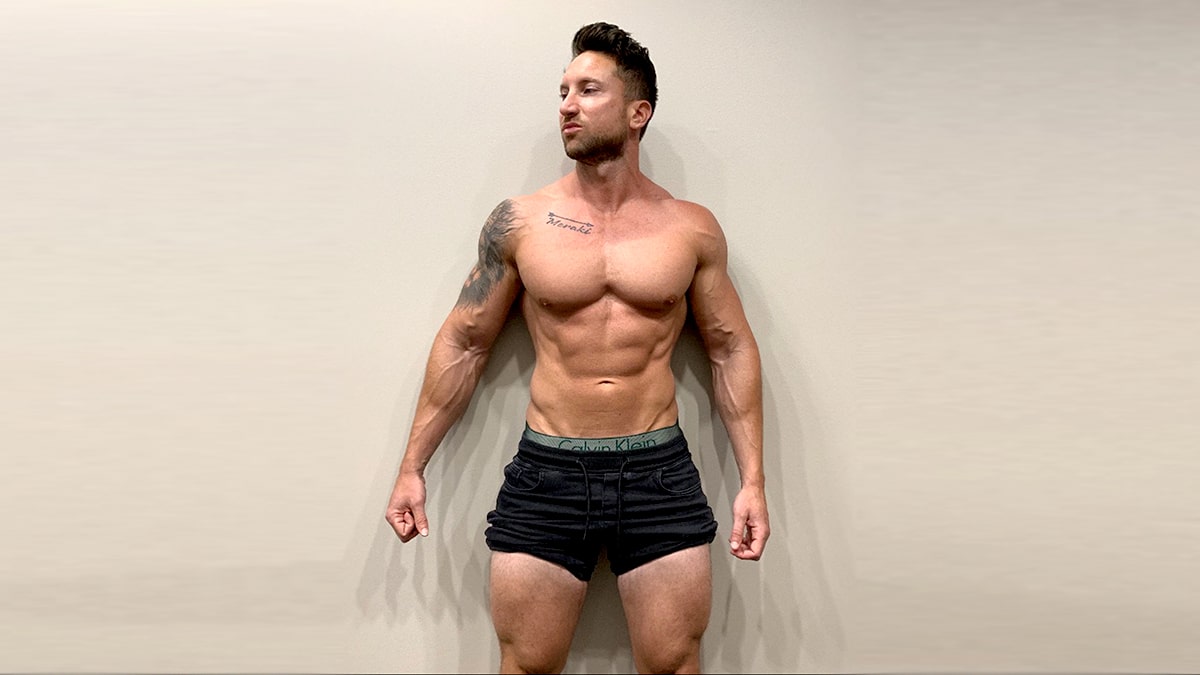
The deadlift is a key exercise that engages and strengthens the lats. However, bigger lats are not just cool; they also signify strength and functionality. Yet, for long-term health, you should take extra care to avoid back pain. Back pain is a leading cause of disability in Americans of all ages, so don't forget to strengthen your back muscles if you're training for strength. A key way to do this is by doing deadlifts or other posterior chain exercises.
Better Posture And Form
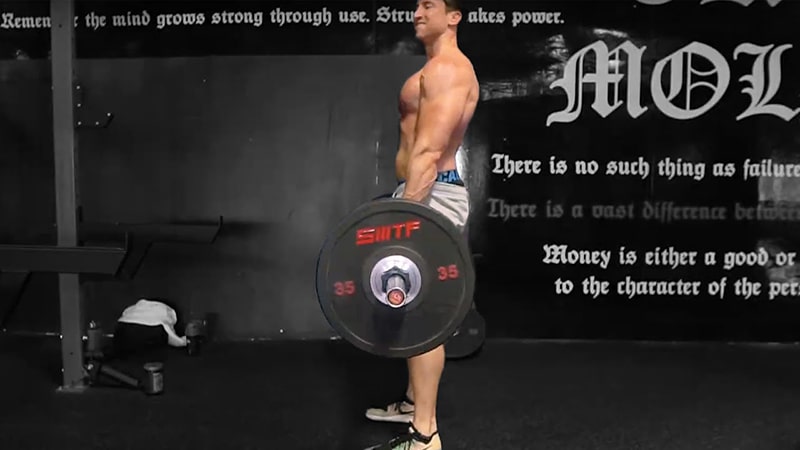
Deadlifts are an effective way to train a neutral spine, hips, and knees. They are the perfect exercise for building good movement habits that apply to your everyday life. For example, when you go to work you’re less likely to bend too far forward and hurt your back while picking up a heavy object, which is the most common type of spinal injury in the workplace.
Deadlifts are a great strategy for improving core strength, core stability, and posture. The movement involves most major leg, lower back, and core muscles — which means that it also strengthens the muscles responsible for proper posture.
Improved Recovery
Deadlifts are excellent for increasing your vertical leap, reducing skeletal muscle loss in the elderly, increasing bone density in athletes who play contact sports, and facilitating functional recovery after a lower-body injury.
Better Hormone Levels
Deadlifts work everything: thighs, core, neck, back, and grip. This means your testosterone and growth hormone levels will skyrocket. Lowered body fat and better moods? Yes! Higher immunity, better sex drive… yes to all that, too!
Stronger Grip
Old-school, hardcore athletes were built strong. They worked hard and had big muscles — specifically big biceps and strong quads. But today, many athletes don’t have that same kind of strength. Often, their grip is the weakest link in the chain. This makes it hard for athletes to exercise. Deadlifts and other power exercises can be especially frustrating when your grip is weak. You can also try things like the double overhand grip or hook grip. Don't barbell deadlift using the underhand grip.
Plenty Of Variations
Of course, you want to stay fresh in the gym. Have fun with deadlifts. There are plenty of ways to mix it up: the Smith Machine deadlift, the Sumo deadlift, the Romanian deadlift, trap bar deadlifts, and rack pulls. So many options! All methods offer different benefits and can find a place in a well-constructed training program.
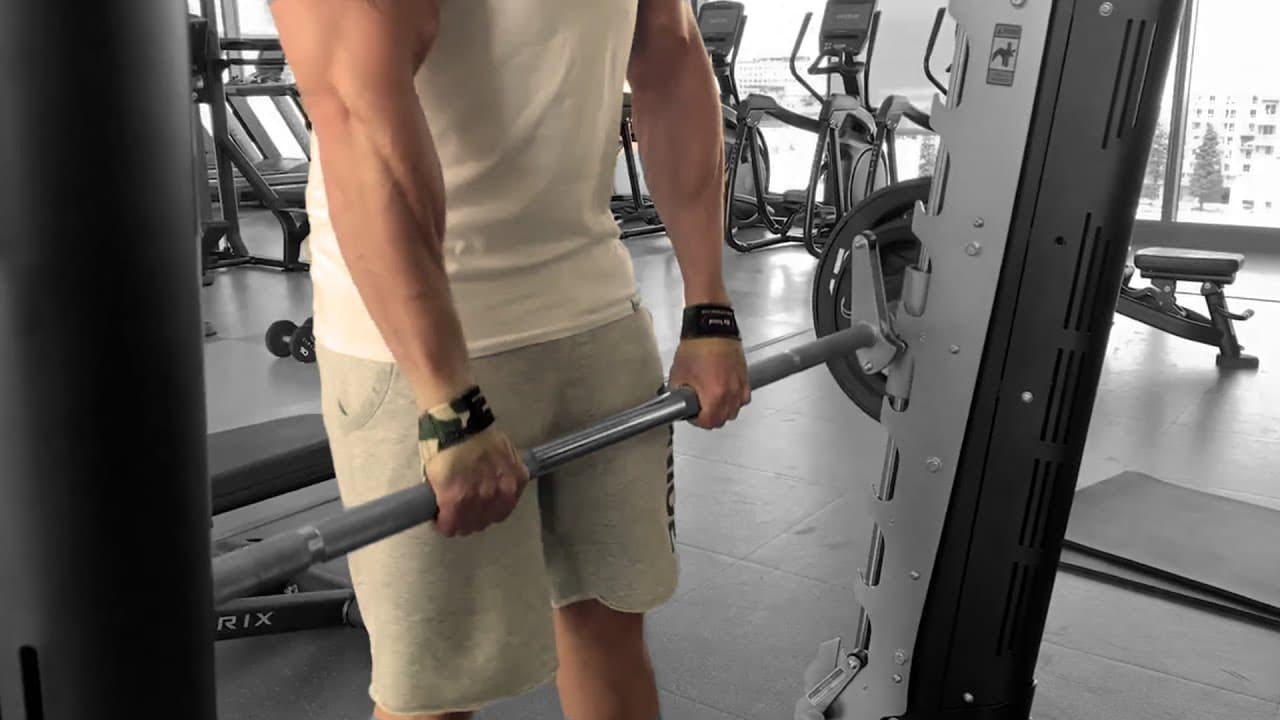
The Romanian deadlift is similar to the conventional deadlift, but it differs in that it begins from a standing position and engages the glutes and hamstrings more. The deadlift begins from the bottom position, engaging more of the quads and mid-back. It is easier to lift heavy with a conventional deadlift than a Romanian deadlift.
The sumo deadlift, which is done with the hands inside of the thighs and a wide stance, is one of the best deadlift variations around. A sumo deadlift is generally done with a wider stance than the conventional deadlift and with the hands inside of the lifter’s thighs.
Find a variety that you enjoy for when you are ready to try something different. When you want to switch things up, there are plenty of movements available for you to choose from.
Stronger Bones
Deadlifts build muscle strength and testosterone, which make the bones in your body stronger. This decreases the risk of osteoporosis and makes you less likely to break down. It’s important for you to build and maintain bone mass, especially as you age.
Muscles Worked By The Barbell Deadlift
The deadlift is a powerhouse exercise. It works multiple muscles and can be a full-body workout. There are a variety of muscles that are worked by deadlifts, including the hip extensors, anterior core, glutes, lower back, latissimus dorsi, biceps femoris, hamstrings, spinal erectors, deltoids, trapezius, serratus anterior, rhomboids, and others.
Deadlifts work every major muscle in your body. Although they’re doing different things, the primary movers are the legs. The back muscles keep you from sagging and let you maintain a good posture. The arms are the ones keeping the weight on the bar.
Shoulders & Back
Back muscles contract and relax to keep your spine in place and gravity pushes it down. Deadlifts are an excellent back builder because they engage all of your back muscles. They work the back and shoulders more than any other exercise, which is why they're a strong choice for anyone's workouts.
When it comes to back workouts, deadlifts and barbell rows are the best. If you add pull-ups in there, you’re set for a strong upper body. Use heavy weights and move quickly to get the most out of this workout circuit. You won’t need much else to build a v-shaped back. Work out two to three times a week and you'll add tons of strength and tone.
Arms
When you lift, the bar puts tremendous pressure on your forearms and mixed grip — which is where you put the most resistance. Your mixed grip tightens to support the bar as you attempt to lift it off the floor, but your biceps and triceps must also work against this resistance. They work to straighten your fingers and squeeze the bar as you pull it up.
Chest & Abs
The core and obliques are what keep your back strong and healthy through physical activity. If you don't use them, they will deteriorate and weaken over time. Diet is also paramount in the development of a functional and strong core. Develop proper body mechanics by working the core muscles regularly with exercises such as farmer's walk, glute-ham raises, single-leg hip thrusts, and of course—the barbell deadlift.
Traps
To deadlift, your trapezius muscles contract to hold your shoulders in place while also transferring force to the bar. The heavier you deadlift, the harder your traps work, and the bulkier they get! You also don’t need to do shrugs mid-rep like you do with the barbell overhead press.
Glutes
In the deadlift, your glutes are targeted throughout their entire range of motion. This is the main reason why it’s one of the best exercises for the butt. Strong glutes mean greater endurance, power, and pain prevention. The gluteus maximus is the biggest muscle in the body and of the three powerlifting movements, nothing targets the butt as hard as the deadlift. Strong glutes mean a heinie that drives your machine.
Legs
The muscles in the back of your legs are straightening your knees, while the front of your legs are straightening your hips. The muscles in the back of your thighs are working first while you control the weight in a deadlift starting position. Then the muscles in the front of your thighs come into play as you fully straighten your knees until standing all the way up.
Barbell Deadlift Safety: Form And Injury Risks
Deadlifting is a great exercise that builds leg strength, but lifting with poor form can decrease strength and increase injury risk. To perform deadlifts correctly, you need to move the weight up from the bottom with a pushing action. Instead of lifting the bar vertically, you pump it.
Deadlifts can turn a weak back into a strong one by strengthening the muscles in your trunk. The deadlift increases back endurance and builds safe movement habits. Gravity pulls the bar down when you deadlift. Your muscles contract to fight gravity and stabilize your spine so it doesn’t bend.
Even if you’re naturally built with short limbs and a long torso, you can figure out how to do a bar deadlift the right way. Those with shorter torsos and longer legs often set up lower than those with longer torsos and shorter legs. Don’t bend your spine to mimic someone else’s deadlift form unless you have the same physique.
When performing the deadlift, it is highly important that you maintain a good deadlift form. A bad way to perform this exercise is to pull from a bent lower back. This can cause injuries to your spinal discs such as bulged discs and pinched nerves. It can also cause back strain or herniated disks.
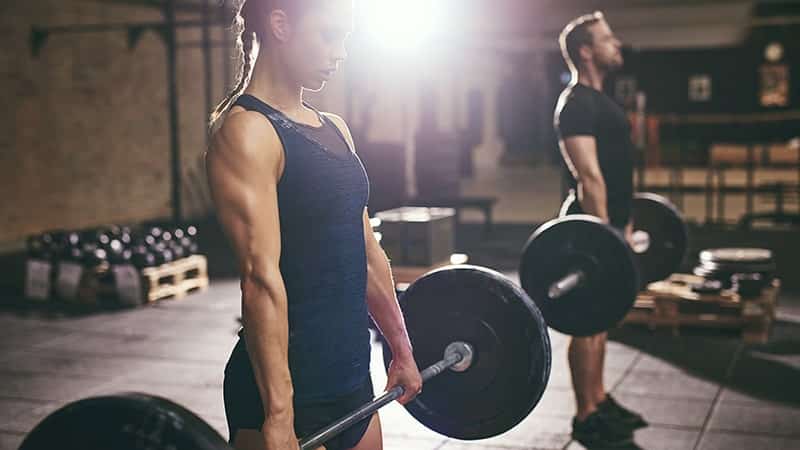
When you deadlift, keep an inward curve in your lower back. Start by using your knees to lower yourself to the bar, then slowly pull the bar to your body. Maintain even the pressure on your discs by keeping a neutral spine throughout the movement. This decreases the chance of injury while doing the deadlift with heavy weights at home.
#5 Farmers Walk Superset with Lunges
Sets | 3 |
Reps | 30 seconds + 8-10 each leg |
Rest Time | 2 minutes |
By The Way, Here’s me going through this entire workout on Youtube!
Seeing results from Full body workouts
Try this full body workout for mass and make sure to train hard and increase the weight each workout. Even adding 5 lbs. On the bar from 1 week to the next makes a huge difference, and will push you to increase the gains you get from these full body workouts.
The sets during this full body workout should be both challenging and fun. On the heavy sets focus on your form and hitting new strength PR’s in the 6-10 rep range, and on the finisher sets these are all about time under tension where the targeted muscle should be screaming!
If you are ready to hop on the fast-lane to your dream body take the free quiz below as well!
